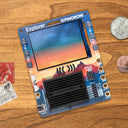Pimoroni Explorer
by Pimoroni




An electronic adventure playground for physical computing, built around the RP2350 chip. Includes a 2.8" LCD screen, a speaker, a mini breadboard, and much more!
Our Explorer lets you play with circuits, build science experiments and prototype tiny robots and inventions. We've incorporated tinkering essentials like:
- a convenient mini breadboard for wiring up components
- servo headers
- analog inputs
- a built in speaker for making beeps and boops
- plenty of general purpose inputs/outputs
- connectors for attaching crocodile leads
- Qw/ST connectors for attaching I2C breakouts
Next to all that lot, there's a vibrant 320 x 240 pixel IPS LCD screen surrounded by six chunky tactile buttons so you can easily monitor and control what your project is doing. It's all mounted on a nice, sturdy baseboard that's printed with a fancy full colour silkscreen. We've also included some little legs, so you can have it propped up at an angle as well as lying flat, and there's a battery connector on the back so you can keep things portable.
You can buy a Pico Explorer board on its own or as part of a Starter Kit, which also contains a hand picked assortment of components to start tinkering with.
Starter Kit contains
- Pimoroni Explorer
- a Multi-Sensor Stick - a fancy new all-in-one super sensor suite for environmental, light and movement sensing
- A selection of different coloured LEDs to get blinky with (including red, yellow, green, blue, white and RGB)
- A potentiometer (for analog amusements)
- 3x 12mm switches with different coloured caps
- 2x continuous rotation servos
- 2x 60mm wheels for attaching to your servos
- an AAA battery holder (you'll need to supply your own batteries)
- Velcro to stick the battery holder to the back of Explorer
- 20x pin to pin and 20x pin to socket jumper wires for making connections on your breadboard
- Qw/ST cable to plug in the Multi-Sensor Stick
- a nice silicon USB-C cable
Features
- Powered by RP2350B (Dual Arm Cortex M33 running at up to 150MHz with 520KB of SRAM)
- 16MB of QSPI flash supporting XiP
- 2.8” IPS LCD screen (320 x 240 pixels)
- Driver IC: ST7789V
- Luminance: 250 cd/m2
- Active area: 43.2 x 57.5mm
- USB-C connector for programming and power
- Mini breadboard
- Piezo speaker
- 6x user-controllable switches
- Reset and boot buttons
- Easy access GPIO headers (6x GPIOs and 3x ADCs, plus 3.3V power and grounds)
- 6x crocodile clip terminals (3x ADCs, plus 3.3V power and grounds)
- 4x 3-pin servo outputs
- 2x Qw/ST (Qwiic/STEMMA QT) connector
- 2-pin JST-PH connector for adding a battery
- Lanyard slot!
- Includes 2x desktop stand feet
- Fully-assembled (no soldering required)
- Programmable with C/C++ or MicroPython
- Schematic
Getting Started
Pimoroni Explorer comes pre-loaded with pirate brand MicroPython and a selection of examples showing off what it can do, so you can start exploring right away. You can find more examples on Github:
Connecting Breakouts
If your breakout has a Qw/ST connector on board, you can plug it straight in with a JST-SH to JST-SH cable, or you can easily connect any of our I2C breakouts with a JST-SH to JST-SH cable coupled with a Qw/ST to Breakout Garden adaptor.
Notes
- Dimensions: approx 107mm x 85mm x 16mm (H x W x D, assembled)
- We'd suggest bending the two metal tabs on the included potentiometer sideways (or removing them with side cutters) so they don't get in the way when you try and plug the pins into your breadboard.
- If you're having difficulty getting the 'legs' on the switches to slot securely into the holes of your breadboard, try straightening them out with pliers.
About RP2350
The RP2350 chip is the Double Quarter Pounder & Fries to the RP2040's Double Cheeseburger and can have one or more RISC-V burgers instead of either of the M33 ARMs, to stretch the metaphor.
In addition to the modern M33 ARM cores, there are sides of: more PIO capability, a variety of low power states for sipping electrons, a whole security system and some sprinklings of specialist digital video circuits to offload DVI/HDMI output.
You can expect a tasty boost in performance - our "real world" MicroPython tests are running up to 2x faster compared to RP2040, and floating point number crunching in C/C++ is up to 20x faster. The extra on-chip RAM will make a big difference when performing memory intensive operations (such as working with higher resolution displays) and even more can be added thanks to external PSRAM support.
RP2350 comes in two flavours - A (standard) and B (all the pins). The B chip has a stonking 48 usable GPIO pins, including 8 ADCs and 24 PWMs, and features on some of our new products.
-
Board Only
PIM720£28.25 -
Starter Kit
PIM744Out of stock£50.00
Shop with confidence – we've been serving the hobbyist electronics, Maker, and retro gaming communities since 2012.
- Satisfaction or refund guarantee
- Worldwide shipping via mail or courier
- 57,000+ customer reviews
- Secure website and payments
